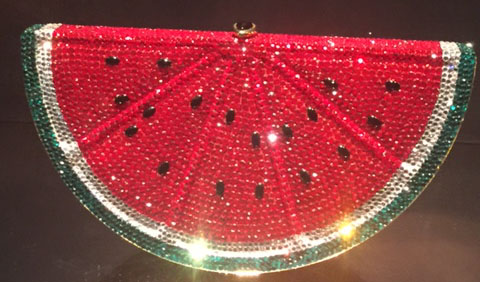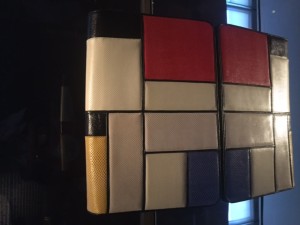
Handbag History: How Judith Leiber Came to Create Her Famous Purses

One of Leiber’s earlier purses on display at the exhibition.
Handbag lovers, design mavens and fashionistas will delight in wide array of bags on display, many from the early period. Even these show a distinct and unconventional flair, like the Mondrian-inspired lizard clutch or the bag formed from a large, gleaming nautilus shell. But it is with the minaudières that Leiber really breaks free. Divorced from utility, practicality and even function, these cunning, crystal-studded creations are to behold, not carry, to enshrine, not wear. Whimsical inspirations from the garden (watermelon, asparagus, tomatoes) or Asian art (the Buddha, the Chinese Imperial guard lions known as foo dogs) abound. So do pigs, birds, and a beehive. While not an exhaustive (or exhausting) show, it’s nevertheless a rich and satisfying one. And the wall notes and timeline provide excellent context in which to place Leiber’s achievements.
Handbags tell a story of women’s place in society as well as their slow march toward autonomy, so it seems hardly accidental that handbags began to assume their greatest importance in the 20th century, just as women began to enter the public domain. Handbags carry money, credit cards, keys, pens, passports, driver’s licenses—essentials for an independent life. Yet they also carry a seemingly endless array of other items—make up, hairbrush, comb, birth control, baby wipes, pacifiers, toys, hand sanitizer, gum, mints, lip balm, Band-Aids, ibuprofen, as well as Ziploc bags of Cheerios or Goldfish, all of which suggests the multiplicity of women’s roles: sexual beings, mothers, caretakers.
Judith Leiber’s glittering baubles will hold none of the above, and most have space for nary more than a single tube of lipstick. Many of them lack handles or straps, so that they must occupy the hands of their wearer at all times. Yet starting with Mamie, they have been coveted and carried by such women as Nancy Reagan, Barbara Bush, Greta Garbo, Mary Tyler Moore, Claudette Colbert, Beverly Sills and Hillary Clinton. Leiber, a Jewish woman who had been disenfranchised by war and politics, went on to create bags that are prized by women of influence and power. That perhaps is part of their lasting charm: these iconic creations look like fairy tale baubles for a princess in a ball gown, but instead they, like the women who wear them, have found their way into the great, wide world that lies beyond the castle walls.
The views and opinions expressed in this article are the author’s own and do not necessarily reflect those of Lilith Magazine.



